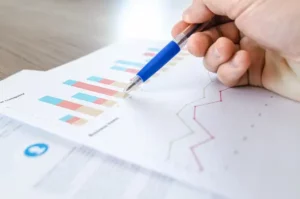The moving average is a technical analysis tool used in forex trading for smoothing out price movements by eliminating ‘noise’ from random price variations.
A Moving Average (MA) is simply the average security price over a given period. The most common periods used for MAs are 15, 20, 30, 50, 100, and 200 days. MAs can be used on any timeframe, from intraday charts to yearly charts. The longer the time frame of the MA, the smoother the price action will be because long-term MAs filter out a lot of the noise that short-term MAs will show.
MAs are lagging indicators, meaning they follow trends. They do not predict trends. Instead, MAs tell you what the price is doing on average over a certain period.
The Different Moving Averages That Can Be Used When Day Trading Listed Options

Several different moving averages can be used when day trading listed options.
Simple Moving Averages
A simple moving average (SMA) is calculated by adding up the closing prices of a security for several periods and then dividing this total by the number of periods.
For example, if you wanted to find the 20-day SMA of stock, you would add up the closing prices for the past 20 days and then divide by 20.
Exponential Moving Averages
An exponential moving average (EMA) gives more weight to recent prices than a simple moving average does.
Traders can use these moving averages to generate a buy and sell signals. For example, if the price of a security is above its 200-day SMA, it is generally considered to be in an uptrend. If the price is below its 200-day EMA, it is considered a downtrend.
Crossover Trading Strategy
One popular way to use moving averages is the crossover trading strategy, which involves buying whenever a shorter-term moving average crosses over and above a longer-term moving average and selling when the shorter-term moving average crosses under the longer-term one.
For example, you could buy when the 50-day SMA crosses above the 200-day SMA and sell when it crosses back below.
The advantage of this trading strategy is that it can help you stay in trend for longer and avoid whipsaws (false signals).
The Disadvantage Of Using Just One Moving Average

A disadvantage of using just one moving average is that it doesn’t consider volatility. For example, if there is a period of high volatility, the moving average will be much more volatile than usual and could give false signals.
This volatility is why some traders use multiple moving averages, such as the 50-day and 200-day SMAs. If one of the moving averages is giving a false signal, the other can confirm it.
The Disadvantage Of Using Two Moving Averages

However, using two moving averages has its disadvantages. The main one is that you will get more false signals because there are now twice as many chances for a crossover.
To avoid this, you could use a longer time frame for one of the moving averages. For example, you could use a 50-day SMA and a 200-day EMA.
Another way to avoid false signals is to wait for the moving averages to converge before trading. For example, you could buy when the 50-day SMA is close to crossing above the 200-day SMA.
When using moving averages, it’s also important to keep an eye on volatility. If there is a period of high volatility, the moving averages will be much more volatile than usual and could give false signals.
Conclusion
The best moving averages for day trading listed options on the forex market are the 50-day SMA and the 200-day EMA. These moving averages will help you stay in trend for longer and avoid whipsaws. However, it would help if you always used multiple indicators to confirm your trades. Before investing in listed options, novice traders should use a reliable and experienced online broker.
- SEO Powered Content & PR Distribution. Get Amplified Today.
- Platoblockchain. Web3 Metaverse Intelligence. Knowledge Amplified. Access Here.
- Source: https://iotworm.com/best-moving-averages-for-day-trading-listed-options/
- 100
- a
- above
- Action
- ADvantage
- always
- analysis
- and
- average
- back
- because
- before
- below
- BEST
- broker
- buy
- Buying
- calculated
- certain
- chances
- Charts
- Close
- closing
- Common
- conclusion
- Confirm
- Consider
- considered
- converge
- could
- day
- Day Trading
- Days
- different
- Disadvantage
- Doesn’t
- doing
- eliminating
- EMA
- example
- experienced
- exponential
- exponential moving average
- eye
- filter
- Find
- follow
- forex
- forex market
- Forex Trading
- FRAME
- from
- generally
- generate
- get
- Give
- given
- gives
- Giving
- help
- High
- Home
- However
- HTML
- HTTPS
- important
- in
- Indicators
- instead
- investing
- IT
- just one
- Keep
- lagging
- Listed
- long-term
- longer
- Lot
- Main
- many
- Market
- MAS
- max-width
- meaning
- more
- most
- movements
- moving
- moving average
- moving averages
- multiple
- Noise
- novice
- number
- ONE
- online
- Options
- Other
- past
- period
- periods
- plato
- Plato Data Intelligence
- PlatoData
- Popular
- predict
- price
- PRICE ACTION
- Prices
- random
- recent
- reliable
- security
- sell
- Selling
- several
- short-term
- should
- show
- Signal
- signals
- Simple
- simply
- SMA
- SMAs
- smoother
- some
- stay
- stock
- Strategy
- such
- Technical
- Technical Analysis
- The
- time
- timeframe
- to
- tool
- Total
- Traders
- trades
- Trading
- trading strategy
- Trend
- Trends
- under
- uptrend
- use
- volatile
- Volatility
- wait
- wanted
- webp
- weight
- What
- which
- will
- would
- Your
- zephyrnet












